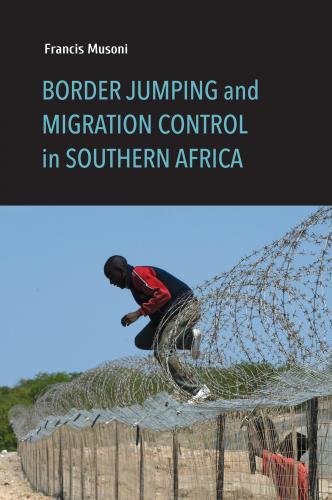BORDER JUMPING AND MIGRATION
CONTROL IN SOUTHERN AFRICA
BORDER JUMPING AND
MIGRATION CONTROL IN
SOUTHERN AFRICA
Francis Musoni
Indiana University Press
This book is a publication of
Indiana University Press
Office of Scholarly Publishing
Herman B Wells Library 350
1320 East 10th Street
Bloomington, Indiana 47405 USA
© 2020 by Francis Musoni
All rights reserved
No part of this book may be reproduced or utilized in any form or by any means, electronic or mechanical, including photocopying and recording, or by any information storage and retrieval system, without permission in writing from the publisher. The paper used in this publication meets the minimum requirements of the American National Standard for Information Sciences—Permanence of Paper for Printed Library Materials, ANSI Z39.48-1992.
Manufactured in the United States of America
Library of Congress Cataloging-in-Publication Data
Names: Musoni, Francis, author.
Title: Border Jumping and Migration Control in Southern Africa/Francis Musoni.
Description: Bloomington, Indiana : Indiana University Press, 2020. | Includes bibliographical references and index.
Identifiers: LCCN 2019980962 (print) | LCCN 2019021140 (ebook) | ISBN 9780253047144 (hardback : alk. paper) | ISBN 9780253047151 (pbk. : alk. paper) | ISBN 9780253047175 (ebook)
Subjects: LCSH: Zimbabwe—Emigration and immigration—History—20th century. | South Africa—Emigration and immigration—History—20th century. | Zimbabwe—Boundaries. | South Africa—Boundaries. | Border crossing—Zimbabwe. | Border crossing—South Africa. | Zimbabweans—South Africa—Social conditions.
Classification: LCC JV9006.15 .M87 2020 (ebook) | LCC JV9006.15 (print) | DDC 325.68—dc23
LC record available at https://lccn.loc.gov/2019980962
1 2 3 4 5 25 24 23 22 21 20
In loving memory of my father—a former migrant, educator, and community leader.
Contents
List of Acronyms and Abbreviations
1Colonial Statecraft and the Rise of Border Jumping
2Promoting Illegality: South Africa’s Ban on “Tropical Natives”
3Border Jumping and the Politics of Labor
4Apartheid, African Liberation Struggles, and the Securitization of Cross-Limpopo Mobility
5Crossing the Boundary Fence: The Zimbabwe Crisis and the Surge in Border Jumping
THIS BOOK WAS conceived around the 2008 outbreak of xenophobic violence in South Africa that left more than fifty migrants dead and thousands others displaced. My original idea was to study the historical construction of foreignness among Zimbabweans in South Africa. I hoped such a study would provide some historical context that was missing in the largely presentist discussions of the violence, which affected migrants from Zimbabwe, Mozambique, and other parts of sub-Saharan Africa, whom South Africans collectively referred to as makwerekwere (foreigners). However, I changed my mind a year later after a few days of research at the National Archives of Zimbabwe in Harare led me to a huge file labeled “Illegal Recruiting of Native Labour, 1925–1951.” In that file, which contained hundreds of documents from various units of the colonial government in Zimbabwe, were reports of the Criminal Investigation Department. One of those reports made reference to a statement dated November 8, 1941, that was ostensibly written by someone identified as “Native” Davidson. It read as follows:
It was my intention today to proceed to Mafeking. I have no Pass to Leave the Territory, nor have I any papers authorising my entry to the Union of South Africa, but I have made arrangements to travel on a goods train which is travelling to the Union this morning. Sometime ago, when I expressed an intention of going to the Union of South Africa, I was told by one of my friends, a native named Jack alias Faison, who works in the Railway Telegraph Office, Bulawayo, that he could arrange that I be taken down South by one of the Europeans employed on the Railways. He mentioned that the charge would be about £2-0-0, and that many natives had been taken down South by this particular person. On the 31st October, 1941, I paid £2-0-0 to native Jack, who said he would hand it to the European concerned. He told me that this European works on the trains which travel down South. I saw Jack alias Faison again on Wednesday 5 November, and he told me that he had handed the money to the European. I don’t know the name of the European. Jack told me to be ready on Saturday morning the 8th November, at the station, and he would give me a note, which had been left with him, to give to me, for purposes of identification, when I joined the goods train. I was told by Jack that he would show me the train on which I was to travel, and there, an arrangement would be made with the European as to how I was to travel (ie in goods truck or compartment, or on the engine, or in the guards’ van). I was not able to go up to the station today, as I was detained by the police, on a native pass charge.1
Although the prevalence of “illegal migration” across the Zimbabwe–South Africa border featured prominently in media and scholarly discussions of the 2008 xenophobic violence, it had never occurred to my mind that there could be a long history of this phenomenon. Not even a single one of the historical studies of migration in Southern Africa, which I had read since my undergraduate years in Zimbabwe, addressed this issue. While a few works made passing reference to work-seeking migrants who sneaked out of colonial Zimbabwe and went to South Africa, they did very little to examine how such people crossed the border between the two countries.
This book contributes to Southern African historiography and migration studies by examining the historical dynamics of cross-border movements that evaded official measures of controlling migration from colonial and postcolonial Zimbabwe to South Africa. It covers the period from 1890, when the British-sponsored settlers occupied the Zimbabwean plateau and created a separate colony from the then Boer-controlled Transvaal colony on the southern side of the Limpopo River, to around 2010. Although
